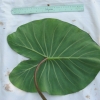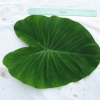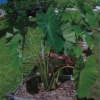Use As Food
Chiefly eaten as table taro; makes poi of fair quality.
Distribution
Limited; grown equally well under māla (upland) or lo‘i (wetland) culture.
General Characteristics
Medium in height to tall, slender, erect, maturing in about 12 months, producing from 2 to 5 ‘ohā; characterized by broad purplish-black stripes on dark green petioles.
Ha (Petiole)
75 to 90 cm. long, clark green with broad purplish-black stripes especially near kōhina (base), with light pink to whitish edge, purplish.red at apex, white at kōhina (base) with livid brown for 3 to 4 cm. above the base.
Lau or Lu'au(Leaf Blade)
35 to 50 cm. long, 25 to 35 cm. wide, 25 to 35 cm. from tip to base of sinus (māwae), arrow head shaped, thin in texture, dark green; margins slightly wave-like (undulate); piko purple; veins reddish on lower surface of round leaf section (lobes); round leaf section (lobes) acute with narrow lihi māwae (sinus).
'I'o kalo (Corm)
Flesh white with yellowish fibers; skin yellowish with purple leaf scars.
Pua (Flower)
Remarks
The Hā (Petiole) stripes are less interrupted than in other striped varieties and very broad, especially at the kōhina (base), often coming together to form purplish-black blotches.

















